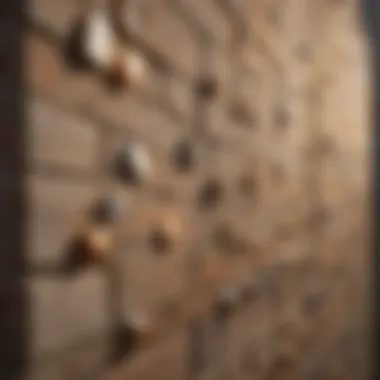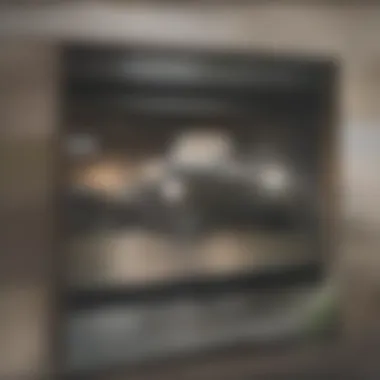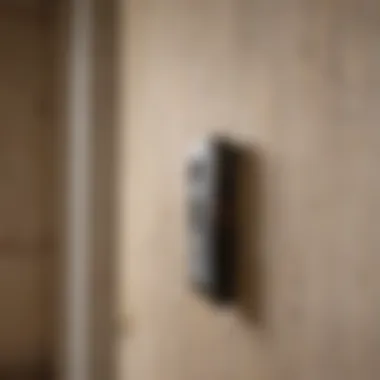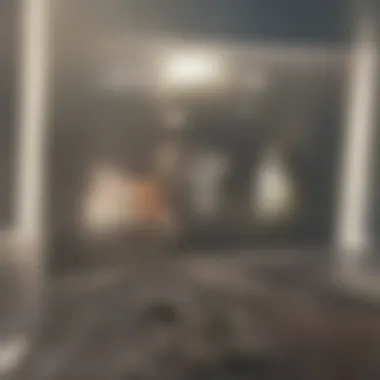Mastering Wall Stud Location Without a Finder


Intro
Finding wall studs is an essential skill for any homeowner or DIY enthusiast. Wall studs provide the necessary support for hanging items such as cabinets, shelves, and artwork. Understanding how to locate them without relying on a stud finder enhances your confidence and expands the range of projects you can undertake. Not only does this skill improve your home décor, but it also ensures that installations are secure and build to last. This guide will provide you with several effective techniques for locating wall studs, emphasizing practical methods that require minimal tools.
Techniques for Locating Wall Studs
Understanding the underlying structure of your walls can significantly enhance your stud-finding abilities. Most walls have studs placed at regular intervals, typically 16 or 24 inches apart, measured from the center of each stud. Here are several methods to locate them:
Knock Method
One common way to find studs is through the knock method. Here's how:
- Stand a few feet away from the wall.
- Use your knuckles to knock on the wall. Notice the sound changes as you move.
- Listen for a solid sound which indicates a stud. A hollow sound suggests you are not on a stud.
- Mark the spot when you find a stud and measure 16 inches to the left or right to locate the next one.
Measuring from Corners
Another method relies on measuring techniques:
- Start by measuring 16 inches from any corner of the wall. Most studs are installed this way.
- Continue to measure every 16 inches along the wall.
- Validate these spots through knocking, if necessary.
Use of a Magnet
Using a small magnet can also be effective:
- Get a small, strong magnet.
- Move it along the wall slowly, feeling for any screws or nails in the drywall. These will typically align with the location of the studs.
- Once you find a magnetic spot, confirm by knocking.
End
Locating wall studs without a stud finder is a practical skill that enhances your ability to undertake home improvement tasks more effectively. By employing techniques such as knocking, measuring, and using a magnet, you can achieve accurate results. This knowledge empowers you to make informed decisions about wall-mounted installations, ensuring they are safe and secure.
With these methods, you can confidently approach any project requiring the knowledge of wall stud placement. Stay tuned as we explore more complex projects and the significance of proper stud placement in your home renovation journey.
Understanding Wall Structure
Understanding wall structure is critical for effectively locating studs without a stud finder. Studs serve as the backbone of a wall, providing essential support for various fixtures and structures. When you understand how walls are built and the role of studs, it becomes easier to locate them using practical methods. Knowing the materials used in wall construction can also enhance your detection techniques. Each type of stud and wall material has unique characteristics that influence their sound, spacing, and visual cues.
The Purpose of Studs
Studs are vertical framing members that offer support to the wall and the load it carries. They are essential in transferring weight from the roof and upper levels to the foundation. Additionally, studs create spaces for insulation and wiring, making them integral in residential and commercial construction. Knowing their purpose uncovers why locating these elements is vital when undertaking home repairs or renovations.
Types of Studs in Construction
Wooden Studs
Wooden studs are perhaps the most common type used in homebuilding. Their availability and ease of handling make them a favorable choice for many DIY projects. A key characteristic of wooden studs is their natural flexibility, which allows them to withstand various load pressures without failing. However, it’s essential to consider that wooden studs can warp or crack over time, depending on environmental conditions. Thus, while they are a traditional choice, homeowners need to monitor their condition regularly.
Metal Studs
Metal studs have gained popularity in commercial buildings and some residential applications. The significant advantage of metal studs is their resistance to fire, rot, and pests. These studs offer uniform strength and do not warp or split as wood can. However, their installation might require specific tools and skills that could pose a challenge for novice DIYers. The investment in metal studs can be justified in environments where durability and safety are paramount.
Engineered Studs
Engineered studs combine wood fibers and resin, resulting in a product that boasts improved strength and stability. Their key characteristic is that they can be manufactured to specific lengths and thicknesses, addressing diverse design needs in construction. While engineered studs can be a more expensive option, their superior performance often justify the cost, especially in applications where structural integrity is crucial.
Common Wall Materials


Drywall
Drywall, or gypsum board, is prevalent in interior wall construction. It is lightweight and easy to install, which supports DIY projects. The smooth surface provides an excellent base for paint or wallpaper, making it visually appealing. However, drywall can be fragile, making it susceptible to dents and damage, particularly in high-traffic areas.
Plaster
Plaster has historically been used as a wall finish. Its density provides excellent insulation and is resistant to fire. While plaster walls can be very durable, they are more complex to repair compared to drywall. This can pose a challenge when locating studs, as the sound does not transmit as effectively through thicker materials.
Plywood
Plywood is commonly used in structural applications, such as sheathing roof and wall assemblies. Its strength comes from the layers of wood glued together, which enhances stability. As a wall material, it can support heavy fixtures and resist warping better than solid wood. On the downside, plywood surfaces are often not as refined as drywall or plaster and may require finishing to achieve a smooth look.
Understanding these core components enhances readers' awareness of their homes, empowering them during DIY projects.
Identifying Stud Locations
Identifying wall studs is a crucial aspect of executing successful home improvement tasks. Knowing where the studs are can help you avoid potential damage when hanging heavy items like shelves or televisions. The importance of precision in this practice cannot be overstated. Accurate stud placement not only ensures the stability of your installations but also aids in protecting electrical wires and plumbing situated behind the walls.
Standard Stud Spacing
Although wall stud spacing can vary, there are common standards to keep in mind when locating them.
16-Inch O.C. (On Center)
One of the most prevalent stud spacings in residential construction is 16 inches on center. This means that the centers of adjacent studs are spaced 16 inches apart. This is a beneficial choice for several reasons. It aligns perfectly with standard sheet materials like drywall, therefore minimizing wastage. The 16-inch spacing also provides ample support for typical fixtures.
24-Inch O.C.
Another common option is 24 inches on center. This spacing is often used in larger wall assemblies and when dealing with lightweight materials. The key characteristic of this spacing is its ability to accommodate larger studs and provide flexibility in design while still maintaining adequate support. However, it might not be suitable for heavier items which require additional stud support, making careful planning essential before proceeding with installations.
Understanding Variations
Every construction project has its unique variables. Understanding these variations can be crucial in accurately locating studs. Older homes may not follow the standard practices that are common today. Studs in these constructions can be inconsistently spaced or even placed at odd angles. Recognizing these differences allows you to adapt your methodology and ensure you locate the studs as accurately as possible.
Listening for Sound Differences
Listening for sound differences is another effective technique. When you gently tap on the wall, a solid sound indicates the presence of a stud, while a hollow sound suggests otherwise. Skilled eyes and ears can make a substantial difference in identifying the right locations.
Visual Cues on the Wall
Awareness of visual cues on the wall can also aid in locating the studs.
Nail Pops
Nail pops are telltale signs of stud locations. These occur when nails that hold the drywall to the studs rise to the surface over time. Noticing these can help you pinpoint the actual stud placements.
Dimples in the Paint
Dimples or slight imperfections in the paint surface may also indicate where fasteners are located. These imperfections can guide you toward optimal stud placement, particularly where movement in the house may have created visible signs.
Outlet Placement
Electrical outlets are typically mounted on the sides of studs. When you find an outlet, you can extend your stud search from that point, usually 16 inches on center left or right from the outlet. This method streamlines the locating process by providing a reference point that is reliable and often easily accessible.
Using Basic Tools for Stud Detection


Using basic tools for stud detection demystifies the process of finding wall studs without relying solely on an electronic stud finder. These methods are straightforward and accessible, enabling anyone to locate studs effectively. This section discusses various tools and techniques that leverage common household items, ultimately enhancing the reader's DIY skills and boosting their confidence in home improvement tasks.
Tapping Method
How to Tap
The tapping method involves using a simple technique where one taps on the wall to find studs. To execute this, gently knock on the wall with your knuckles, moving from one side to the other. The key characteristic of this method lies in sound detection. When tapping over a stud, the sound changes compared to tapping on a hollow section of the wall. This method stands out due to its accessibility; it requires no special tools, only your hands and a little practice to master.
One advantage of the tapping method is that it allows for immediate feedback. You can intuitively learn to identify the different sounds produced by the wall. However, it can require patience and good listening skills. The technique also may not be suitable for all wall types, especially dense materials that absorb sound more than standard drywall.
Interpreting Sound Changes
Interpreting the sound changes during the tapping method is crucial for identifying a stud's location. When you hear a solid sound, it indicates you are above a stud, while a hollow sound suggests an empty cavity. This understanding helps in narrowing down the stud's position, making it an effective tactic.
The key here is rhythm and consistency. The ability to distinguish between these two sound qualities makes this method popular amongst DIY enthusiasts. However, its downside includes the potential for misinterpretation, as ambient noise can disrupt sound clarity. Being attentive and patient is essential when using this technique.
Magnet Method
Selecting the Right Magnet
The magnet method is another effective technique for detecting wall studs. Selecting the right magnet is important, as not all magnets are created equal. A small, strong magnet is ideal for finding screw heads and metal fasteners used in stud construction. This method is straightforward and provides quick results.
A key characteristic of the magnet method is its simplicity and non-invasive nature. You do not need to make any markings or holes in your wall. Additionally, this method is particularly beneficial when dealing with metal studs or screw-mounted wooden studs. However, a disadvantage is that it requires understanding what exactly you are searching for, as it may not distinguish between different types of metals effectively.
Locating Screw Heads
Locating screw heads using the magnet method can significantly expedite stud detection. As you glide the magnet along the wall, you will notice it sticking where screws are installed. This technique directly points to areas where studs likely are located.
The unique feature of this method lies in its efficiency. You can cover large wall areas quickly, making it a favorite among those who appreciate speed and precise results. However, it's worth noting that sometimes screws may be spaced irregularly or located near other fixtures, which could confuse the process. Familiarity with your wall's context enhances the effectiveness of this method.
Specialized Tools You May Have
Level Tools
Level tools, such as spirit levels, can assist in finding wall studs by creating reference lines. While their primary purpose is to ensure objects are level, they can also help detect subtle characteristics of a wall that could indicate stud placements. A straight line can provide a visual guide for where to tap or measure.
The usefulness of level tools lies in their ability to aid in precision tasks. Using a level can improve the accuracy of your stud measurements, ensuring that you are marking the correct locations. However, it may require additional steps, such as measuring, which might not appeal to everyone seeking a quick solution.
Tape Measure
A tape measure is a valuable tool for locating studs, particularly when used in conjunction with knowledge of standard stud spacing. Using a tape measure involves measuring 16 or 24 inches from a known starting point—usually an outlet or light switch. This method presumes knowledge of the standard spacing and is more effective in homes built to these specifications.
The tape measure's key characteristic lies in its versatility. It is not only useful for measuring stud placement but also for various other home projects. A limitation of this method, however, includes the reliance on assumptions about stud spacing, which can vary in older homes or custom builds. Consequently, combining this method with others provides the best results.
Advanced Techniques for Accurate Detection
Accurate detection of wall studs is crucial for any DIY project that requires secure mounting. Advanced techniques offer homeowners and DIY enthusiasts the option to improve precision in locating studs, ensuring that installations are safe and effective. These methods build on the basic identification techniques discussed earlier, adding layers of reliability to the stud-finding process. By employing lights, creating references, and testing wall depth, one can achieve heightened confidence in the locations of structural elements hidden behind walls.
Use of Lights and Shadows
Utilizing light creates a visual enhancement that aids in identifying the contours of the wall surface. By shining a bright flashlight or LED light along the wall at an angle, shadows can reveal slight variations in texture. Where studs might be located, the surface may appear more rigid, while spaces between studs might show a smoother texture.
Experimentation with light positioning is essential. Move the light around to see how shadows cast over bumps, dips, or textures change. This technique is particularly useful in homes where the wall is painted or finished in a way that might obscure visual cues.
Creating Reference Marks


Once the location of a stud is identified, making reference marks offers a way to keep track of positions across the wall surface. Use a pencil or small adhesive note to mark the spot. This simple technique enables easier layout planning for fixtures, shelves, or other mounted items.
Reference marks can also help while working on larger projects. As one moves across the wall, these markers can provide a guide, reducing guessing and improving overall alignment in installations.
Testing for Wall Depth
Testing for wall depth is a more invasive but effective method for confirming stud locations. It often involves creating small test holes to see what is behind the wall material.
Drilling Small Test Holes
Drilling small test holes is a selective technique that allows for direct verification of stud presence. The key characteristic of this method is its precision. It aids in confirming where to find the stud before making larger openings. Holes should be small enough to keep repairs minimal if needed afterward.
This technique is beneficial for individuals who prefer certainty. It can provide a clear indication of how deep a wall is and the space behind it. A disadvantage could be that it creates a small risk of damaging infrastructure within the wall, such as wiring or plumbing. Prior knowledge of layouts often prevents these problems.
Interpreting Findings
Interpreting findings from drilled holes allows one to discern various materials within the wall. For example, if a drill penetrates a stud, the resistance will be different compared to when it encounters plaster or drywall.
Being able to identify what is behind the wall is crucial for safety and effectiveness. The unique feature of this interpretation lies in its accuracy—it distinctly reveals wall structure when coupled with other techniques. The downside, however, is that it does introduce permanent marks on the wall, which might require subsequent repair work.
In summary, advanced techniques such as using light, creating reference marks, and testing for wall depth equip homeowners with a robust toolkit for detecting wall studs more accurately.
Best Practices and Safety Considerations
When locating wall studs without a stud finder, best practices and safety considerations are crucial. This article emphasizes the need to follow specific protocols to ensure accuracy and protect oneself from potential hazards. Understanding the layout of electrical and plumbing components, as well as minimizing damage to wall surfaces, is key. These practices not only enhance the effectiveness of your DIY projects but also uphold safety measures essential in home improvement tasks.
Avoiding Electrical Obstacles
Electrical wiring is often concealed within wall cavities, running parallel to studs. Encountering live wires during your search for studs can be dangerous. To avoid electrical hazards, take these steps:
- Know the layout: Familiarize yourself with the electrical grid of your home. Understanding common placements of outlets and switches helps predict where wires might be located.
- Turn off power: Before starting any work, turn off the power to the room at the circuit breaker. This step allows for safer exploration.
- Use a multimeter: For added protection, a multimeter can be used to check for current in the area where work will be done. This tool can alert you to any lingering electrical issues.
Understanding Plumbing Layouts
Plumbing pipes can also pose significant challenges when searching for studs. They are typically embedded in walls and may lead to leaks if disturbed. To circumvent these plumbing pitfalls:
- Know where pipes are: Research typical plumbing layouts for houses of your style and age. Pipes are often situated near sinks and connected to fixtures.
- Listen for sounds: Pay attention to sounds from behind the wall, like running water or echoes. This might indicate a pipe's location near your stud search area.
- Be cautious: Use caution when drilling holes, even small ones, in drywall. If you suspect plumbing is present, it might be wise to use a stud search method that does not involve drilling or excessive impact.
Minimizing Damage During Detection
Minimizing damage is integral when locating wall studs. Wall repairs can be costly and time-consuming, so employing careful methods is important:
- Tapping softly: Use the tapping method gently to avoid creating unnecessary holes. Gradually increase tapping intensity until you identify stud locations.
- Mark lightly: When you do find a stud, mark the location with a pencil or chalk lightly. Avoid large circles or deep marks that will require patching later.
- Patch responsibly: If damage occurs, use appropriate fillers and finish to restore the wall. Repairing small holes is straightforward, but taking shortcuts can lead to larger issues later.
Keeping these best practices and considerations in mind will greatly enhance your experience in locating wall studs. Safety should always be the foremost priority in any DIY endeavor.
Culmination
Recap of Techniques
Various methods are at your disposal when it comes to locating wall studs.
- Standard Stud Spacing: Knowing that studs are typically spaced either 16 or 24 inches apart gives you a solid starting point.
- Listening for Sound Differences: Tapping on the wall to hear sound variances can reveal stud locations quite effectively.
- Visual Cues: Observing signs like nail pops or paint dimples can guide you to the stud positions.
In addition, using basic tools like magnets or specific tapping techniques can enhance your accuracy. Each method complements the others, allowing for greater precision in your detection efforts. Consider integrating these approaches into your toolset and choose the method that fits your needs best.
Encouragement for DIY Projects
Understanding how to find wall studs without specialized tools empowers homeowners and DIY enthusiasts. It encourages confidence in home projects, enabling you to mount shelves, hang artwork, or install heavy fixtures safely. The ability to accurately locate studs minimizes risks associated with improper installation and potential accidents.
As you take on your next DIY endeavor, remember to utilize the techniques outlined in this article. They will provide you with a foundation of knowledge that can significantly enhance your project outcomes. Embrace this skill, and let it motivate you to take on new challenges around your home. Your ability to secure items properly and safely in wall structures will result in a more effective and harmonious living environment.







